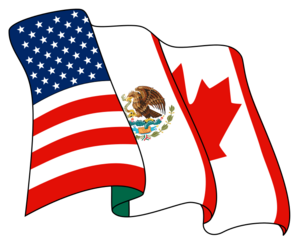North American Free Trade Agreement (NAFTA) (Customs Glossary)
| This article is part of the Customs Glossary Guide |

The North American Free Trade Agreement (NAFTA) was a landmark trade agreement between the United States, Canada, and Mexico, established on January 1, 1994. NAFTA aimed to create a free trade zone among these three countries, eliminating most tariffs and trade barriers, and fostering economic cooperation and growth within North America. This article defines the North American Free Trade Agreement and explores its pivotal role in shaping North American trade.
What is the North American Free Trade Agreement (NAFTA)?
The North American Free Trade Agreement (NAFTA) was an international trade agreement signed by the governments of the United States, Canada, and Mexico in 1992. It came into effect on January 1, 1994, and marked one of the most significant regional trade agreements in history. The primary objective of NAFTA was to promote economic integration and foster trade relations among the three nations, ultimately leading to increased investment, job creation, and economic growth within the region.
Role of NAFTA in North American Trade:
Elimination of Tariffs and Trade Barriers:
One of the key contributions of NAFTA was the gradual elimination of tariffs and trade barriers on qualifying goods traded between the three countries. By removing most customs duties, quotas, and other restrictions, NAFTA facilitated the seamless flow of goods across borders, leading to an exponential increase in cross-border trade volumes.
Market Access and Increased Competitiveness:
NAFTA created a level playing field for businesses within the region, providing them with greater access to each other's markets. This expanded market access improved the competitiveness of North American industries on a global scale, attracting foreign investments and encouraging the development of new supply chains.
Services and Investment Liberalization:
Beyond trade in goods, NAFTA also included provisions to facilitate trade in services and liberalize investment regulations. The agreement aimed to promote cross-border investments, encourage innovation, and enhance the exchange of services such as banking, telecommunications, and professional services.
Intellectual Property Protection:
NAFTA strengthened intellectual property rights protection and enforcement within the region. This provision fostered innovation and creativity, encouraging businesses to invest in research and development while ensuring the protection of their intellectual property assets.
Environmental and Labor Standards:
NAFTA included side agreements addressing environmental and labor concerns. These agreements aimed to promote sustainable development, protect the environment, and ensure that economic growth was accompanied by advancements in labor standards and workers' rights.
Regional Supply Chains and Manufacturing Integration:
NAFTA played a pivotal role in shaping regional supply chains, particularly in the manufacturing sector. By allowing manufacturers to source components and materials from other NAFTA countries without facing significant trade barriers, the agreement encouraged the integration of production processes across borders.
Conclusion
The North American Free Trade Agreement (NAFTA) had a profound impact on North American trade, revolutionizing the way goods, services, and investments were conducted within the region. By eliminating trade barriers, fostering economic cooperation, and promoting market access, NAFTA significantly boosted trade volumes and economic growth among the United States, Canada, and Mexico. While NAFTA was replaced by the United States-Mexico-Canada Agreement (USMCA) in July 2020, its legacy continues to shape North American trade and economic relations, providing a foundation for future collaboration and prosperity within the region.
